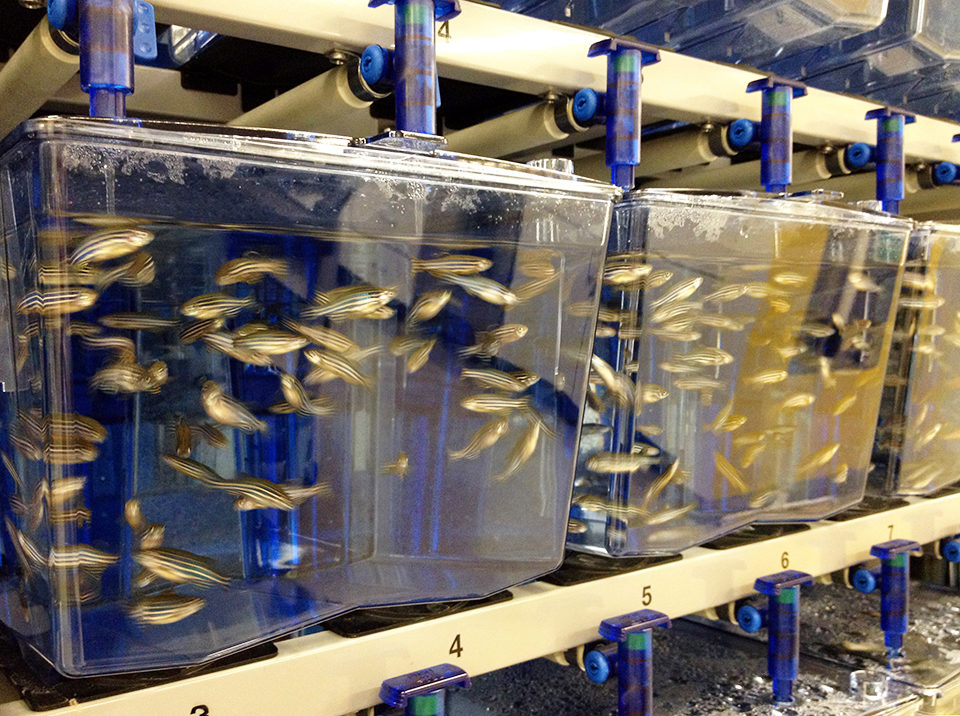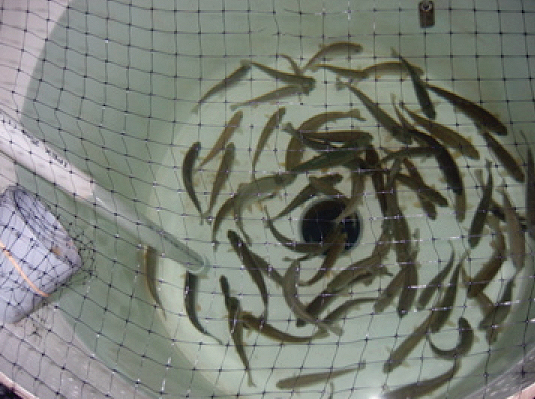Feed formula with artemia replacement a more cost-effective solution

Despite being a diminutive species whose members weigh no more than 10 grams when fully grown, zebrafish (Danio rerio) are hugely important to a wide variety of scientific fields, including human disease research, developmental biology and genetics, environmental toxicology, drug screening, evolution and also aquaculture. There are an estimated 2,000 zebrafish laboratories in the United States alone, and a priority for every facility is to produce embryos of high quality that are suitable for the aforementioned research.
Care for these animals has traditionally been a very labor-intensive process, but a new study published by the Aquatic Resources Program at Children’s Hospital Boston in Massachusetts, USA, identified a valid alternative requiring less labor. Results indicated that feeding juvenile zebrafish just once a day with a specially formulated feed that replaces the conventional Artemia salina nauplii can improve growth and offer a more cost-effective feeding solution with no adverse impact on reproductive performance.
Mainstream model
The zebrafish model system has been around for a long time, but in the last two or three decades in particular, its usage has accelerated in a wide variety of scientific disciplines. In recent years, therefore, a number of attempts have been made to improve the understanding of the animal’s key biological characteristics, particularly in the areas of nutrition, reproductive biology, larviculture, behavior and natural history.
The hospital report, “The Effects Of Feeding Frequency On Growth And Reproduction In Zebrafish,” found these and other emerging data hold promise for use as a framework for developing more sophisticated, performance-driven management practices befitting the animals’ status as a mainstream research model.
Laborious inputs
While humans and fish are separated by more than 450 million years of evolution, there is still a great degree of genetic similarity between the two – as much as 75 percent, which is why biomedical researchers increasingly favor the zebrafish model. Other important features of zebrafish include their ease of culture and very short generation time with rapid development and maturity.
Zebrafish laboratories typically have thousands of 3-L aquariums, each housing a dozen fish. Each laboratory has to dedicate a staff member to repetitively service each aquarium by taking the water temperature or feeding the fish. Each visit to a tank is called an input.
The standard practice is to feed postlarval zebrafish two to five times daily, 365 days per year, usually with a combination of Artemia salina nauplii and a formulated rotifer diet. While many laboratories have employed this extremely labor-intensive feeding strategy for decades, its effects on performance had not been evaluated.
The Children’s Hospital Boston researchers wanted to see if the husbandry could be simplified to reduce the number of inputs without compromising embryo production. These trials were the first formal evaluation of feeding practices in zebrafish beyond the juvenile stage.
Feeding trials
Starting at 30 days post-fertilization (dpf), the researchers fed eight replicate groups of age- and strain-matched fish a commercial pelleted diet – Gemma Micro 300, manufactured by aquaculture feeds specialist Skretting. The groups received feed either once every other day or one time, three times or five times daily to achieve a total feed input of 5 percent body weight/day compared against a standard control of Artemia salina nauplii/metanauplii given three times daily to apparent satiation.
Once every other week, beginning at 30 days and ending at 150 dpf, each replicate tank was taken off the system and photographed from above with a digital camera. At least 10 randomly selected fish in each replicate were measured for fork length from the tip of the snout to the end of the middle of the caudal fin rays. Immediately after they were photographed, the fish in each replicate group were weighed.
Specific growth rates were calculated for each replicate tank for each sampling date. Aside from the first week, efforts were made to conduct growth measurements on a biweekly basis. At 150 dpf, the sex ratio of each treatment group was determined by counting the number of males and females in each tank.
Positive results
Researchers found that in general, the fish fed the commercial diet at 5 percent body weight one, three or five times daily showed superior growth performance when compared with both the control and every-other-day feeding regimes, and did not compromise embryo quality.
They further learned that while increasing the feeding frequency beyond once daily did result in heavier females, on average, it did not significantly impact the rate of growth. This has potentially important implications for how zebrafish aquaculture facilities are managed, particularly with respect to the time and labor spent on feeding.
From start to finish, the study took eight months, which resulted in fish grown to sexual maturity. The researchers found the difference in the time it takes staff to feed a given facility containing hundreds or thousands of tanks once versus two or three times daily is significant.
The time savings gained could translate to reductions in operating costs and/or an increased dedication of personnel to performing higher-order management tasks, such as genetic management and pathogen control, which are often neglected because of staffing shortages.
Artemia replacement
Another important aspect of the study was to establish if Artemia could be eliminated completely from the zebrafish diet because Artemia is a live animal and therefore quite variable – from its nutritional value and where it is harvested, to how it is enriched and packaged. Artemia also require a labor-heavy laboratory process of hatching and treating before they can be fed to study fish.
The superior growth of the fish in the one, three and five daily feeding groups may have also been attributed to the differences between the nutrient profiles of the commercial diet and the Artemia used in the study’s controls.
In particular, newly hatched Artemia are known to be deficient in essential polyunsaturated fatty acids, particularly docosahexaenoic acid (DHA) and arachidonic acid (ARA), both of which are important for zebrafish growth and development. The commercial diet, meanwhile, had defined levels of DHA, EPA and other essential fatty acids.
Robust embryos
Much of the research on zebrafish in the biomedical arena is on the production of embryos that are used as research subjects. The main aim of all zebrafish laboratories is to produce very robust embryos for use in scientific studies.
Yet no study prior to that undertaken by Children’s Hospital Boston had extended experiments out to repeatedly measure reproductive performance over such a long period of 190 days. This was a unique aspect of the Boston study.
The hospital’s spawning trials commenced at 76 dpf. Once every other week, two males and three females were randomly selected from each replicate tank and set up in a standard mating cage, yielding a total of 8 crosses/treatment and 40 total crosses/event. With nine events, there were a total of 360 crosses, 72 per treatment.
If crosses were successful, the embryos were collected, rinsed with system water, transferred to petri dishes and incubated overnight at 280 degrees-C. This was repeated once every other week for nine weeks until the end of the experiment at 191 dpf.
The fact that the commercial diet was able to give better growth and economics while eliminating artemia would be immaterial if reproductive performance was negatively impacted, and embryo production was compromised. However, the study found that in fish fed the formulated diet, there was no negative impact on reproductive performance as measured by sex ratio, crossing success, fecundity and fertility. Furthermore, the embryos produced during a spawning event were of superior quality.
(Editor’s Note: This article was originally published in the January/February 2013 print edition of the Global Aquaculture Advocate.)
Now that you've reached the end of the article ...
… please consider supporting GSA’s mission to advance responsible seafood practices through education, advocacy and third-party assurances. The Advocate aims to document the evolution of responsible seafood practices and share the expansive knowledge of our vast network of contributors.
By becoming a Global Seafood Alliance member, you’re ensuring that all of the pre-competitive work we do through member benefits, resources and events can continue. Individual membership costs just $50 a year.
Not a GSA member? Join us.
Authors
-
Jason Holland
Fish and Seafood Consultant
London, United Kingdom -
Christian Lawrence
Aquatic Resources Program
Children’s Hospital Boston
One Blackfan Circle
Boston, Massachusetts 02115 USA[117,100,101,46,100,114,97,118,114,97,104,46,104,99,116,46,115,114,101,100,110,101,64,101,99,110,101,114,119,97,108,99]
-
Nick King
Technical Manager
Marine Hatchery Feeds
Skretting
Tagged With
Related Posts

Intelligence
On GM foods, part 4: Let’s examine our needs
Scott Nichols concludes his four-part series about GM foods with a simple question about transgenic animals: Are they truly meeting a need? We need more food and we need better nutrition. Both desires should be achieved without increasing environmental impacts.

Health & Welfare
A holistic management approach to EMS
Early Mortality Syndrome has devastated farmed shrimp in Asia and Latin America. With better understanding of the pathogen and the development and improvement of novel strategies, shrimp farmers are now able to better manage the disease.

Health & Welfare
Algae shows promise as alternative DHA source in rainbow trout diets
A growth trial in Canada evaluated the use of algae biomass to increase the concentration of long-chain polyunsaturated fatty acids in the tissues of rainbow trout.

Aquafeeds
A look at phospholipids in aquafeeds
Phospholipids are the major constituents of cell membranes and are vital to the normal function of every cell and organ. The inclusion of phospholipids in aquafeeds ensures increased growth, better survival and stress resistance, and prevention of skeletal deformities of larval and juvenile stages of fish and shellfish species.



